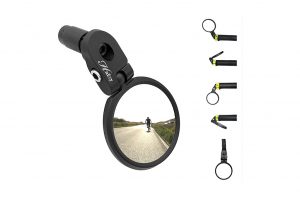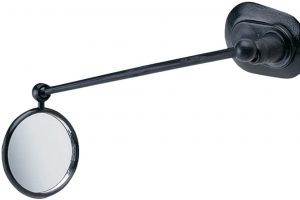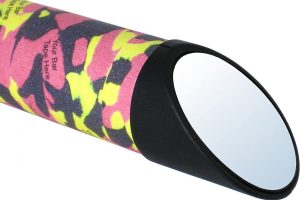The 10 Best Bike Mirrors in 2020
On today’s busy roads, one of the best pieces of equipment you can invest in is a quality bike mirror to give you excellent vision and visibility. Although racing and mountain biking enthusiasts often turn up their noses at them, there’s an undeniable advantage to being able to see what’s coming up behind you while keeping good posture and one eye to your front, as well.
- But aren’t all bike mirrors the same?
- Are they worth the money at all?
After all, they just help you see to the rear, right?
Well, not quite.
Here are some important features to look for if you’re after the best bike mirror.
- Mirror size determines how wide is your rearview.
- Mirror placement can be anywhere from the bar ends, top of the handlebar, or your helmet.
I’ll discuss them (and more) in detail in the buying guide section below to help you determine the one that suits your needs. In the end, I’ll also share some of the popular mirrors among cyclists.
A Quick Glance : Our Favorite Bike Mirrors
Bar End Mirror Picks
Hafny

Hafny is a small Taiwanese company that focuses on bike components, and their attention to detail and care for durability and ease of use is obvious in their signature bar-end bike mirror.
The convex 62mm lens is made from highly polished stainless steel, which offers exceptional clarity as well as a safe, unbreakable material. The mounting pin fits into handlebars with an inside diameter of 17mm to 21mm, and it works equally well for right and left-hand mounting.
- Pros : Large 62mm lens provides wide rearview coverage.
- Cons : Susceptible to vibrations on rough roads.
Cateye BM-500

Cateye was founded in Osaka, Japan in 1954, and they’ve got the benefit of 60 years of leading the industry in lenses and bicycle lighting. The Cateye BM-500 is a solid, lightweight bar-end mirror designed to fit most bikes and provide comprehensive rear visibility at a low cost.
It carries a large (109.6mm x 70.4mm) scratch-resistant convex glass mirror, providing a durable, wide field of view for rides. Adaptable and sturdy, it’s better suited to smaller diameter handlebars between 16mm and 22mm usually found in mountain bikes.
- Pros : Solidly built and lightweight.
- Cons : Not suited for handlebars with a larger diameter above 22mm.
Third Eye
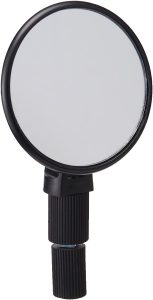
Third Eye has produced a solid option with its straightforward, reliable bar-end mirror.
The lens is impressively compact at 76mm, descended from an original design consisting of a dentist’s mirror. It’s made from scratch-resistant glass with a slightly convex shape, which allows it to capture a wide field of vision.
Mounted with rubber washers and a screw-in tightener at the bar-end, it comes with additional rubber shims to ensure a snug fit and folds up easily to save space.
- Pros : Easy to install on most bars.
- Cons : Compact-sized lens might not suit everyone.
Handlebar Mirror Picks
Meachow
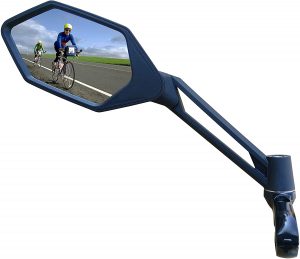
Definitely one of the cooler-looking options available, the Meachow is an angular, handlebar-mounted mirror with impressive engineering.
The safety glass lens offers high-definition visuals and an anti-glare coating (50% for the silver lens, 75% for the blue).
The lens assembly can be rotated 360° for complete vision, and it’s mounted on an impact-resistant fiber-reinforced nylon arm. Anchored on a durable aluminum alloy clamp, this mirror is tough, highly reflective, and perfect for keeping an eye out.
- Pros : Nice-looking and durable design, similar to a motorcycle mirror.
- Cons : Arms are prone to snapping if the bicycle falls.
Zefal Spy
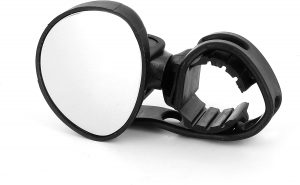
For commuter cyclists who want a different view than the one you get from handlebar mirrors, there’s the Zefal Spy.
This mirror requires no tools for mounting, and the versatile clamp can be attached nearly anywhere on your frame.
Because of the low-demands clamping mechanism, this means it can also be attached comfortably to most frame styles and shapes, with a diameter of 22mm to 66mm. The small 50mm x 40mm lens is made of resilient chrome-plated plastic, offering lasting reflectivity.
- Pros : Easy to mount, no tools required.
- Cons : Expect to pay a premium over other brands.
Jeemitery
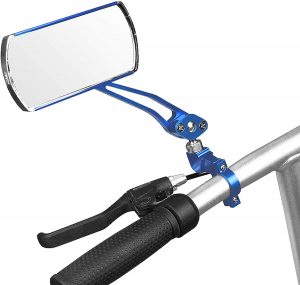
Jeemitery’s handlebar-mounted bike mirror is simple, clean, and handy, locking onto diameters of 22mm to 25mm with a minimal screw-on clamp. The lens measures 100mm in length and is composed of shatterproof glass in an ABS housing.
Supported by a simple metal arm, the lens assembly offers the standard 360° as well as flexibility for height adjustment. It also incorporates the considerate feature of a reflective stripe on the back of the mirror housing so that oncoming vehicles will be better able to see you in low-light conditions.
- Pros : Durable, shatterproof glass with wide coverage.
- Cons : Mounting system is prone to loosening over bumpy roads.
Bike Helmet Mirror Picks
Blackburn
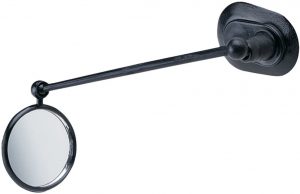
The Blackburn is a helmet-mounted mirror that allows you to synchronize your rear visibility with your own motion and your natural field of vision. Attached with a mounting plate and adhesive pad, it’s suitable for any helmet with sufficient surface area for the mount.
Although the lens is small, it offers crystal clear reflections and low weight to avoid neck fatigue. It’s mounted on a fully adjustable ball fitting so that it can be quickly and easily set to your preferred viewing angle and comes with a limited lifetime warranty.
- Pros : Compatible with the majority of helmets out there.
- Cons : Smaller lens limits rearview coverage.
Cycleaware
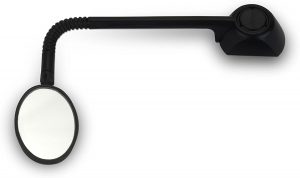
The modular Cycleaware Reflex mirror is another helmet-mounted option featuring terrific visuals and easy use. The base attaches permanently to a helmet’s surface, while the mirror can be quickly detached and stored.
One of the unique features of the Reflex is the flexible, wire-based arm, which is coated in Kraton, a high-performing plastic, resulting in a flexible, durable stem that allows you to adjust it to your precise needs.
The lens itself is more elongated vertically than other mirrors, so you can enjoy a greater depth of field while riding.
- Pros : Mirror can be easily detached from the helmet when not needed.
- Cons : Mounting is not sturdy for rougher roads.
Drop Handlebar Mirror Picks
IRBM
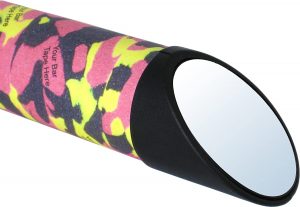
The IRBM (or Italian Road Bike Mirror) is a clean, solid, reliable piece of bike rear view mirror with a unique design.
Compact and solid, it’s 53mm by 33mm, and it won’t shift or vibrate once installed.
The mirror is seated under the bar tape and inserted into the drops, then secured in place and covered over with bar tape again. This seamlessly integrates it into your handlebars for flawless vision.
- Pros : Clean and sleek integration with road bikes.
- Cons : Sold as a single mirror rather than a pair
Sprintech

The award-winning Sprintech has been setting the standard for drop-mounted mirrors since 1996. The brainchild of Italian-Swiss inventor Carlo Dondo, these hoof-shaped mirrors slot easily and firmly into drop handlebars, while their unique shape offers a sharp reflection of oncoming traffic.
The slightly convex plastic mirrors are coated in nine layers of chrome for durability and crisp imagery. Installation is easy and quick, with the underlying mount fitting tightly into the opening while the removable mirror slots in and out with ease.
- Pros : Convex mirrors provide crisp imagery.
- Cons : Bulkier compared to its peers.
Bicycle Mirrors Buying Guide
You might think that a bike mirror is more of an option that you don’t really need to be safe and secure while riding.
And for most of us who cut our cycling teeth without accessories like these, that might make sense. But it’s unbelievably safer not to have to twist, turn and shift to see behind you, and for giving you a full view of the road to enjoy your ride safely, there’s nothing like a quality bike mirror.
When you’re considering a bike mirror, there are several important qualities to look out for and that will help you determine what’s best for you.
Here are 5 important things to know before buying bike mirrors.
1. Types of Bike Mirrors
You’ll generally see 3 types of bike mirrors in the market today. Each one is designed for the same purpose but implemented differently.
- Bar-end mirrors such as the Hafny, Cateye BM-500, Third Eye, IRBM, or Sprintech are mounted to the end of the flat handlebars such as those found in mountain bike and cruiser bikes.
- Handlebar mirrors consist of a mirror assembly affixed to an arm, which wraps around the bike handlebars. With bike handlebar mirrors, you’ve got the room to place the mirrors between the stem and your handlebar grips. The Meachow, Zefal Spy and Jeemitery mirrors are all examples of this type.
- Helmet mirrors are mounted on your helmets, like the Blackburn and the Cycleaware Reflex. They have the advantage of staying in your field of vision no matter what so that you don’t have to adjust your body to suit the mirror, but rather, the mirror follows along with your sight.
2. Left vs Right Sided Mirrors
Which side of your handlebars or helmet you mount your mirror on is largely a matter of preference.
In the U.S., we drive (and cycle) on the right-hand side of the road, so most of us are accustomed to looking left when looking for a rearview mirror.
Through force of habit, then, most riders prefer the left. If you’re able and willing to drop money on a second mirror, then it doesn’t hurt to have a right-mounted one, but it’s not necessary.
3. Mirror Size
While it can be easy to assume that a larger mirror is better, it’s best not to rely on this belief.
A larger mirror has a couple of disadvantages in that it offers more surface for glare and, if glass, is sure to break more easily.
On the other hand, smaller mirrors sometimes don’t offer the scale you need to see clearly, so they shouldn’t be your go-to, either.
Ultimately, the size you opt for depends on what you’re comfortable with and what offers you the best view. While some might prefer a larger or smaller mirror, the majority of riders will find themselves settling on a happy medium.
4. Adjustability
You’re unlikely to always be in the same position, so you must give yourself the option to adjust your mirror as needed.
Handlebar-mounted mirrors, in particular, are prone to vibrations, so if that’s your preferred style, you must have the ability to keep it focused and in place.
Otherwise, if you go for something a little more permanent like the IRBM, you’ll need to make certain the position and viewing angle are perfect from the get-go.
5. Compatibility
Keeping compatibility in mind will save you a ton of stress and strain when you’re looking for a bike mirror because not every mirror will fit every frame or even be appropriate for them if they do.
A lightweight bar-end mirror, for example, isn’t the ideal choice for a scrape and crash-prone mountain bike, nor is a thinner handlebar mirror the best idea for someone looking to build up high speed on the road.
Most manufacturers will make it plain which types of frames and handlebars their mirrors are suitable for, so keep a close eye on each product’s product information.

